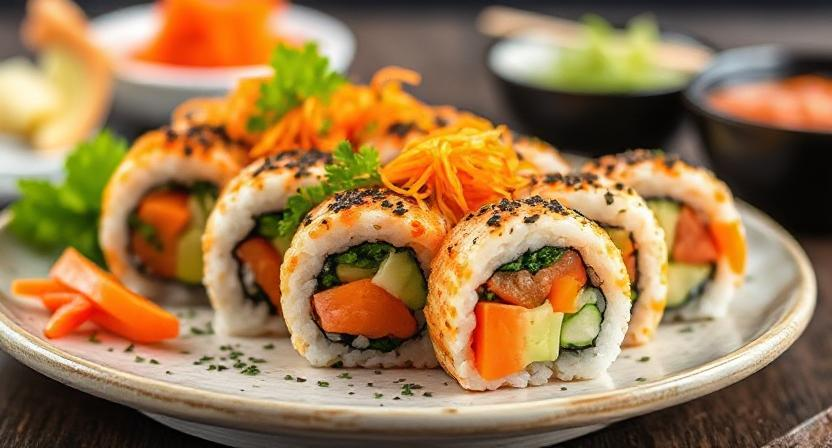
Sushi, a culinary delight adored by millions worldwide, has a fascinating history that blends tradition, innovation, and cultural exchange. Today, sushi is synonymous with Japanese cuisine, yet its origins and evolution reveal a story of adaptation, creativity, and influence from neighboring cultures. So, how did sushi become the iconic dish we know and love today? Let’s take a journey through its history, invention, and rise to global popularity.
The Invention of Sushi: A Culinary Evolution
Sushi’s roots can be traced back over 1,000 years to ancient Southeast Asia, where a method of preserving fish using fermented rice was first practiced. This early form of sushi, called nare-zushi (or fermented sushi), involved storing fish in rice to allow it to ferment. The rice was discarded after fermentation, and only the preserved fish was eaten. This technique was popular in China and later spread to Japan.
Over time, the Japanese refined and adapted this method, particularly during the Edo period (1603-1868), when nigiri sushi (hand-pressed sushi) began to emerge. It was during this period that sushi evolved into the form we recognize today—fresh fish placed atop a small mound of vinegared rice. This shift toward using vinegar in the rice was a crucial innovation, as it eliminated the need for fermentation, making sushi faster to prepare and more accessible to the masses.
Where Was Sushi Invented?
While sushi’s earliest forms originated in China, it was in Japan that the dish truly evolved into what we recognize today. The Edo period in Japan, particularly in the bustling city of Edo (modern-day Tokyo), was the birthplace of the nigiri style of sushi. During this time, sushi became not just a method of preserving fish but a fast, convenient, and flavorful meal for the working class.
The transformation from a preserved dish to a quick and enjoyable street food happened with the help of Japanese innovators like Hanaya Yohei, who is credited with inventing the nigiri sushi in the early 19th century. His creation of the hand-pressed sushi, where raw fish and vinegared rice were combined in a compact form, revolutionized sushi and made it a popular snack in the busy streets of Edo.
How Sushi Became Famous Worldwide
Sushi remained a staple of Japanese cuisine for centuries, with its popularity largely confined to Japan. However, the post-World War II era saw major changes in the global landscape, including increased international travel, trade, and cultural exchange. As Japan opened up to the world, Japanese food culture began to gain international recognition, and sushi was one of its most celebrated dishes.
- The Rise of Sushi in the U.S.
Sushi’s journey to global fame began in the United States in the 1960s, particularly in California. The first sushi bar in America is said to have opened in Los Angeles in 1966, but it was the creation of the “California Roll” that truly marked sushi’s breakthrough. This sushi roll, invented by Japanese chef Ichiro Mashita, featured avocado, a native Californian ingredient, alongside the traditional sushi filling. It was a fusion that appealed to Western tastes and helped make sushi more approachable for the American palate. - Sushi Becomes a Global Phenomenon
In the decades that followed, sushi’s popularity spread across the world. Cities like New York, London, Paris, and Sydney embraced sushi, opening countless sushi restaurants and bars. As health-conscious dining became a global trend in the 1980s and 1990s, sushi, with its fresh fish, low-calorie content, and vibrant presentation, became the go-to meal for many people around the globe. Furthermore, the growing trend of international tourism also contributed to sushi’s rise. People who traveled to Japan returned home with a new appreciation for sushi, and as the world became more interconnected, Japanese food culture was more easily shared and enjoyed. - Sushi in the 21st Century
Today, sushi can be found on nearly every continent, from upscale sushi bars to conveyor belt sushi restaurants, and even in grocery stores in the form of pre-packaged rolls. Modern variations of sushi, such as sushi burritos, sushi pizza, and vegan sushi, have sprung up to cater to diverse tastes and dietary preferences.
Why Has Sushi Become So Popular?
Several factors have contributed to sushi’s rise to global fame:
- Health and Freshness
Sushi is often viewed as a healthy option due to its reliance on fresh ingredients, such as fish, vegetables, and rice. Many people also appreciate that sushi is generally low in fat and high in protein and omega-3 fatty acids, making it an attractive option for health-conscious individuals. - Cultural Appeal
Sushi’s cultural significance and aesthetic appeal have also played a role in its popularity. The artistry of sushi-making, from the precision of cutting fish to the careful assembly of each roll, attracts food enthusiasts who appreciate both the taste and the craftsmanship involved. - Adaptability
Sushi has proven to be incredibly adaptable to different tastes. Variations like the California Roll, spicy tuna rolls, and vegetarian options make sushi accessible to a wide range of people. The versatility of sushi allows chefs to experiment with new flavors and ingredients, further expanding its appeal. - Globalization and Travel
With globalization and the increasing number of international travelers, food cultures have blended in ways that have introduced people to different cuisines. Sushi, once a delicacy enjoyed primarily in Japan, has become a symbol of Japanese cuisine and culture that can be found in nearly every corner of the world.
Conclusion: A Dish for the Ages
From its humble beginnings as a method of preserving fish to its current status as a global culinary icon, sushi has undergone a remarkable transformation. Today, sushi is not just a food but a cultural phenomenon that brings people together, bridges culinary divides, and offers a taste of Japan’s rich history and tradition. Whether served as traditional nigiri, creative rolls, or sushi bowls, this dish’s journey from Japan to the world is a testament to the power of food to transcend borders and unite people across cultures.
As sushi continues to evolve and be reimagined, its roots in Japanese tradition remain, ensuring that this dish will continue to be loved for generations to come.
More About us
For More Cooking Course you Can Visit our Website




